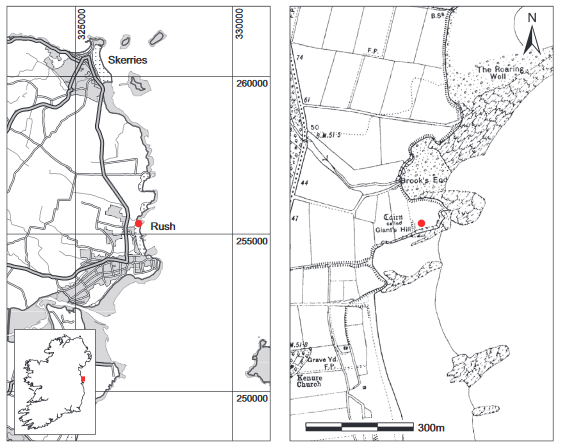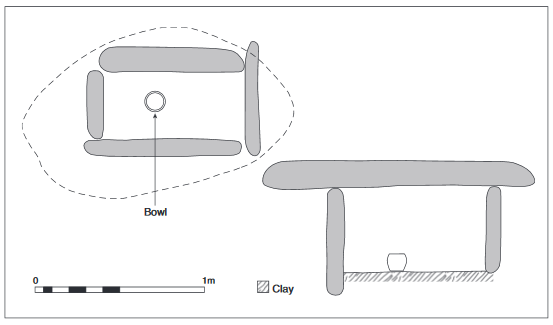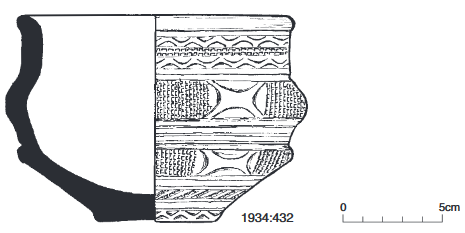1934:015 - RUSH, CO. DUBLIN, Dublin
County: Dublin
Site name: RUSH, CO. DUBLIN
Sites and Monuments Record No.: SMR DU008-013002
Licence number: E1062
Author: SEÁN P. Ó RÍORDÁIN AND LIAM PRICE
Author/Organisation Address: —
Site type: Early Bronze Age graves
Period/Dating: —
ITM: E 726934m, N 755355m
Latitude, Longitude (decimal degrees): 53.532798, -6.085230
Introduction
In April 1934, while reclaiming land adjacent to Giant’s Hill passage tomb at Rush, Co. Dublin, William McGuinness discovered a cist burial containing an inhumation accompanied by a bowl. The bowl was broken in his effort to remove it. Mr McGuinness then informed the Gardaí, who instructed him to leave the cist intact pending an investigation. The Gardaí reported the discovery to the NMI. The site was investigated three days after its discovery by Seán P. Ó Ríordáin and Liam Price. This report is based on their notes and illustrations. The human remains found in the cist were examined by Laureen Buckley.
Location(Fig. 3.59)
The cist was in the townland of Rush, north-east Co. Dublin.83 It was located at the northern end of a passage tomb cairn called Giant’s Hill or Knocklea. The cairn was much reduced in size in 1934 from what it once had been, as indicated on the first edition OS 6in. map (see transcript below). It lay approximately 30m from the coast on a headland between the northern end of Rush strand and a cove called Brook’s End, at an altitude of 0–15m above sea level. A cist containing a bowl had also been discovered by Mr McGuinness’s grandfather in what was then the eastern part of the cairn.84 A second vessel was also apparently found. According to Newenham (1836, 249; transcribed below, pp 179–80), a ‘rudely formed grave’ containing human remains was also discovered outside the western end of the cairn and at the edge of a cliff.
Description of site
At the time of investigation, the mound over the cist consisted of a long, narrow mound of stones, mostly large, water-rolled pebbles, and formed part of a field boundary (see transcript below for a full description). The cist was rectangular in plan, measuring 0.82m long by 0.39m wide by 0.49m high.85 It was formed of four side slabs set on edge, each one making up a side.

Fig. 3.59—Locationmap, Rush, Co.Dublin.

Fig. 3.60—Plan andsection of grave, Rush,Co. Dublin.
These were regular in outline, but that at one end was taller and placed about 0.12m deeper in the ground to stand level with the other end stone (Fig. 3.60). The maximum thickness of these slabs was 0.13m and the maximum height 0.612m. The capstone was oval in outline and measured 1.5m long by 0.936m wide by 0.18m thick. There was no evidence of packing stones around the cist. The floor of the cist was formed of well-packed clay. The pit dug to receive the cist does not appear to have been located.
The cist contained the unburnt remains of at least one young adult (1934:433) accompanied by a bowl. Very little of the bone survived apart from a few teeth and some other bone fragments. The exact location of the bones within the cist is not known. According to the sketch of the grave, the bowl was found upright to one side of the cist. It is of the necked bipartite type as classified by Ó Ríordáin and Waddell (1993, 175).
Pottery
Necked bipartite bowl, 1934:432(Fig. 3.61)
This was complete when discovered in the cist but was broken by the finder. It has since been reconstructed. The rim of the vessel is slightly everted, undecorated and has an inward bevel. Below the rim is a double chevron in relief and a double row of horizontal comb lines between. The vessel has two raised panels decorated with vertical bands of comb ornament, the spaces between left plain having four-pointed rectangular stretched-hide motifs in relief. Between the mouldings is a groove ornamented with four horizontal rows of incised lines. Near the base is a plain band and below it slanting rows of comb indentations, and near the bottom is a chevron in false relief.
Dimensions: H 10cm; ext. D rim 14.5cm; D base 6cm.

Fig. 3.61—Ceramicvessel, Rush, Co.Dublin.
Comment
The bowl found in Kenure House and acquired by the NMI in 1965 through the Land Commission contained a small quantity of cremated bone. It is a ribbed bowl with simple decoration arranged in vertical panels (Ó Ríordáin and Waddell 1993, 216, no. 291).
Samples from both burials have been dated. A sample of the human remains from the cist associated with the bipartite bowl excavated in 1934 was submitted for AMS dating and yielded a date of 3670±40 BP, which calibrates to 2195–1939 BC.86 A sample of cremated bone from the ribbed bowl (found in the nineteenth century) yielded a date of 3440±35 BP, which calibrates to 1881–1666 BC.87 This date is too late for a ribbed bowl of this type and Brindley (2007, 58) is of the opinion that the cremated bone found in the bowl is a mis-association. Brindley places the necked bipartite bowl in stage 2 (2080–1980 BC) of the development of the bowl tradition, while the ribbed bowl is placed in stage 3 (1980–1930/20 BC) (Brindley 2007, 173–5, 328).
The discovery of several early Bronze Age cist burials in the cairn of a passage tomb is notunusual and there are many other examples of similar secondary use of earlier monuments,such as the passage tombs at Fourknocks, also in north County Dublin, and the Mound of the Hostages at Tara, Co. Meath.
HUMAN REMAINS
LAUREEN BUCKLEY
Introduction
1934:433—there were very few remains left and they were very fragmentary and decayed. Most of a left tibia shaft was present and appeared to be from a juvenile or adolescent individual. There were also five fragments of long bones that could not be identified but they may have been from a femur. Some loose molar teeth were also present.
Dentition
There was virtually no wear on the teeth, apart from slight polishing of the first molars.
Calculus
No calculus deposits were noted.
Hypoplasia
Pits of hypoplasia were noted on the maxillary second molar.
Summary and conclusions
There were very few remains left to examine and they were extremely decayed. One long bone may have been from a juvenile or adolescent, although there was so much decay that the original thickness of the bone could not be determined. Assuming that the teeth were from the same individual, it appears that the remains were those of a very young adult.
TRANSCRIPT FROM PROCEEDINGS OF THE ROYAL IRISH ACADEMY 1 (1836), 247–9
The barrow, called Knocklea, or the Giant’s Hill, is situated on the edge of the cliff, about midway between the village of Rush, County of Dublin, and the Martello tower to the northward, called Dromanick, and immediately in front of Sir William Palmer’s residence,Kinure Park.
It appears to have been composed of quantities of boulder stones and earth heaped up into a conical form, and sloping away to the base, which was square, as appears from the eastern angle, which yet remains perfect. Within the base of the mound, there was a circle formed of large stones placed on their ends, and about one hundred paces in circumference. Dr. Smith read a paper (by Lieutenant Newenham, R.N.), ‘On a tumulus or barrow, near Rush, County of Dublin’.
The farmer who rents the land on which it stands has removed about one-half of the mound, for the sake of the earth as a manure, and nearly one-half of the circle of stones on the south side, for the purpose of building a wall, part of which is erected on the stones forming the western side of the circle. In the course of his depredations, he discovered a passage which opened on the south side; its entrance was funnel-shaped, and the walls of this passage were formed of flagstones placed on their ends, and roofed in with the same. It was about eleven yards long and one in width; and led to a low chamber about eight feet long, and six wide, which was situated nearly in the centre of the barrow, and formed of stones in the same manner as the passage.
The farmer removed all the stones forming the western side of the passage, and in the course of his excavations, found some human bones on the south side of the chamber, and within the circle of stones. The lines of stones forming the sides of the passage appear to continue on through the mound towards the north side; and a few feet below the present surface of the barrow, a little to the north of the chamber, there is a bed of periwinkle shells, about eight inches thick, with some limpet and muscle [sic] shells intermixed; and beneath this bed of shells there is a quantity of rich dark mould, with some reddish earth which has the appearance of being burned. A few human bones, and some bones of small animals, were found in the earth beneath.
Outside the circle of stones, and on the very edge of the cliff, near the western angle of the mound, there was found a rudely formed grave, containing a human skull, with the bones of the arm, leg and thigh, which apparently had never been disturbed; the bones of the back, ribs &c., could not be discovered.
83. Parish of Lusk, barony of Balrothery East. SMR DU008-013002-. IGR 327011 255334.
84. The bowl (1965:20) was discovered in Kenure House, Rush, Co. Dublin, in 1965 and donated to the NMI by
the Irish Land Commission. It contained a small amount of cremated bone (1965:21).
85. The orientation of the grave was not noted by the excavators.
86. GrA-24157.
87. GrA-14071.
